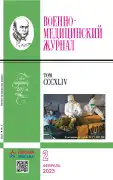The use of extracorporeal isolated perfusion of the injured limb in the experiment: the experience of the tactical-special exercises «Ochag-2022»
- Authors: Reva V.A.1, Potemkin V.D.1, Ibragimov R.I.1, Ershov E.N.1, Tatarintsev S.A.2, Denisov A.V.1
-
Affiliations:
- The S.M.Kirov Military Medical Academy of the Ministry of Defense of the Russian Federation
- Multidisciplinary Research and Education Center «Duokor»
- Issue: Vol 344, No 2 (2023)
- Pages: 43-49
- Section: Treatment and prophylactic issues
- URL: https://journals.eco-vector.com/0026-9050/article/view/630130
- DOI: https://doi.org/10.52424/00269050_2023_344_2_43
- ID: 630130
Cite item
Abstract
Staged treatment of combat injuries of the major vessels of the extremities always carries the risk of developing severe ischemia with a high probability of amputation of the limb or death of the wounded. One of the proven ways to restore limb perfusion is temporary vascular replacement, which requires a complex surgical intervention, the success of which depends on many factors. To maintain perfusion, we proposed to use an extracorporeal circulation circuit connected outside the area of damage to the main artery and allowing blood to be pumped into the ischemic limb within the framework of the concept of temporary extracorporeal perfusion of the limb until the final restoration of blood flow. The paper describes the first experience of using this technology, tested during the Ochag-2022 military medical tactical and special exercises, and shows that it is a option for maintaining perfusion of the injured limb at the stages of medical evacuation.
About the authors
V. A. Reva
The S.M.Kirov Military Medical Academy of the Ministry of Defense of the Russian Federation
Author for correspondence.
Email: vreva@mail.ru
доктор медицинских наук, подполковник медицинской службы
Russian Federation, St. PetersburgV. D. Potemkin
The S.M.Kirov Military Medical Academy of the Ministry of Defense of the Russian Federation
Email: vreva@mail.ru
лейтенант медицинской службы
Russian Federation, St. PetersburgR. I. Ibragimov
The S.M.Kirov Military Medical Academy of the Ministry of Defense of the Russian Federation
Email: vreva@mail.ru
лейтенант медицинской службы
Russian Federation, St. PetersburgE. N. Ershov
The S.M.Kirov Military Medical Academy of the Ministry of Defense of the Russian Federation
Email: vreva@mail.ru
кандидат медицинских наук, подполковник медицинской службы
Russian Federation, St. PetersburgS. A. Tatarintsev
Multidisciplinary Research and Education Center «Duokor»
Email: vreva@mail.ru
Russian Federation, St. Petersburg
A. V. Denisov
The S.M.Kirov Military Medical Academy of the Ministry of Defense of the Russian Federation
Email: vreva@mail.ru
кандидат медицинских наук, подполковник медицинской службы
Russian Federation, St. PetersburgReferences
- Котив Б.Н., Самохвалов И.М., Бадалов В.И. и др. Военно-полевая хирургия в начале XXI века // Воен.-мед. журн. – 2016. – Т. 337, № 5. – C. 4–10.
- Рева В.А., Юдин А.Б., Денисов А.В. и др. Временное эндоваскулярное протезирование артерий – новое решение в лечении тяжелой сосудистой травмы // Воен.-мед. журн. – 2017. – Т. 338, № 9. – C. 15–19.
- Самохвалов И.М., Петров А.Н., Рева В.А. Боевые повреждения кровеносных сосудов: особенности диагностики и лечения огнестрельной и минно-взрывной травмы // В кн.: Сосудистая хирургия: Национ. рук-во. Краткое издание / Под ред И.И.Затевахина, А.И.Кириенко. – М.: ГЭОТАР-Медиа, 2022. – С. 320–341.
- Agarkov M., Reva V.A., Evreeva S. et al. A case of temporary extracorporeal shunting after suprarenal REBOA to facilitate prolonged proximal aortic control of a ruptured abdominal aortic aneurysm in a resource-limited environment // J. Endovasc. Resusc. Trauma Manag. – 2021. – Vol. 5, N 3. – P. 55.
- Bonnet S., Gonzalez F., Mathieu L. et al. The French Advanced Course for Deployment Surgery (ACDS) called CoursAvancй de Chirurgieen Mission Extйrieure (CACHIRMEX): history of its development and future prospects // J. Royal Army Med. Corps. – 2016. – Vol. 162, N 5. – P. 343–347.
- Botden S.M.B.I., Bцkkerink G.M., Leijte E. et al. Training the component steps of an extra-corporeal membrane oxygenation (ECMO) cannulation outside the clinical setting // J. Artif. Organs. – 2020. – Vol. 23, N 4 – P. 328–334.
- Gornati V.C., Utsunomia K., de Lima T.B. et al. Development of a puncture technique for implanting temporary vascular shunts in a porcine model // Ann. Vasc. Surg. – 2019. – Vol. 60. – P. 455–462.
- Hanley S.C., Neequaye S.K., Steinmetz O. et al. Sheath-shunt technique for avoiding lower limb ischemia during complex endovascular aneurysm repair // J. Vasc. Surg. – 2015. – Vol. 62, N 3. – P. 762–766.
- Patel J.A., White J.M., White P.W. et al. A contemporary, 7-year analysis of vascular injury from the war in Afghanistan // J. Vasc. Surg. – 2018. – Vol. 68, N 6. – P. 1872–1879.
- Ratnayake A., Samarasinghe B., Bala M. Outcomes of popliteal vascular injuries at Sri Lankan war-front military hospital: case series of 44 cases // Injury. – 2014. – Vol. 45, N 5. – P. 879–884.
- Reva V.A., Madurska M., Samokhvalov I. et al. The role of endovascular stents in an experimental model of traumatic arterial occlusion – the temporary endo-shunt // J. Endovasc. Resusc. Trauma Manag. – 2020. – Vol. 4, N 1. – P. 40–48.
- Simone M.D., Vaira M. Hyperthermic isolated limb perfusion. In: Madame Curie Bioscience Database [Internet], Landes Bioscience, 2013.
- Villamaria C.Y., Eliason J.L., Napolitano L.M. et al. Endovascular Skills for Trauma and Resuscitative Surgery (ESTARS) course: curriculum development, content validation, and program assessment // J. Trauma Acute Care Surg. – 2014. – Vol. 76, N 4. – P. 929–935.
- Willy C., Hauer T., Huschitt N. et al. «Einsatzchirurgie» – experiences of German military surgeons in Afghanistan // Langenbeck’s Arch. Surg. – 2011. – Vol. 396, N 4. – P. 507–522.
Supplementary files







